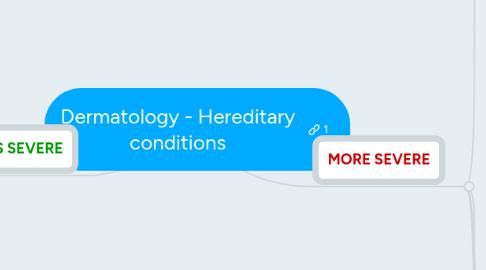
1. LESS SEVERE
1.1. Keratosis pilaris
1.1.1. Autosomal dominant. Common.
1.1.1.1. Cause: unknown!
1.1.2. Follicular bumps
1.1.2.1. Mainly on thighs and arms.
1.1.3. TREATMENT:
1.1.3.1. Softening cream if necessary.
1.1.3.2. Severe? Retinoid cream!
1.2. Keratodermia Palmoplantaris
1.2.1. Dominant. Cause unknown.
1.2.1.1. More common in northern sweden!
1.2.1.2. Also acquired as rare paramalignant side effect of Lung cancer!
1.2.2. Hyperkeratosis on palms & soles
1.2.2.1. Fungal infections common.
1.2.2.2. Sharp border between healty skin and hyperkeratosis!
1.2.3. TREATMENT
1.2.3.1. Softening & keratolytic creams
1.2.3.2. Severe cases: Oral retinoids
1.3. Darier disease
1.3.1. Autosomal dominant.
1.3.2. Cause: Mutated Ca2+-ATPase →
1.3.2.1. Defected keratinocyte maturation
1.3.2.2. (Sometimes) Mild CNS symtoms
1.3.3. Brownish, moist, follicular keratoses
1.3.3.1. Smelly due to 2´ infections
1.3.3.1.1. Worsened by hot moist weather.
1.3.3.2. Debuts in puberty
1.3.4. DIFFERENTIAL:
1.3.4.1. Seborroic eczema
1.3.5. TREATMENT
1.3.5.1. 5% urea cream
1.3.5.2. 1% chlorhexidine cream against smell
1.4. Keratodermia climacteria
1.4.1. Similar to K. Palmoplantaris, but...
1.4.1.1. only occurs in menopausal women
2. MORE SEVERE
2.1. Ichthyosis
2.1.1. Ectodermal symptom
2.1.1.1. Hyperkeratosis, dry, scaly skin
2.1.2. TYPES:
2.1.2.1. I. vulgaris
2.1.2.1.1. Appears months after birth
2.1.2.1.2. Cause: Mutated profilaggrin-gene →
2.1.2.1.3. Picture (palm)
2.1.2.2. Lamellary I.
2.1.2.2.1. Symptoms at birth, "collodion baby"
2.1.2.2.2. Prevalence: 1 to 100.000.
2.1.2.2.3. Cause: Mutated transglutaminase →
2.1.2.2.4. Pic (hands of 10yo boy)
2.1.2.3. Bullous I.
2.1.2.3.1. =Epidermiolytic hyperkeratosis
2.1.2.3.2. Causes large blisters
2.1.2.4. X-linked recessive I.
2.1.2.4.1. Only affects men. Prevalence 1:3000
2.1.2.4.2. Cause: Lack of steroid sulphatase →
2.1.3. TREATMENT
2.1.3.1. The common types are helped by
2.1.3.1.1. Summer sun
2.1.3.1.2. Salty baths
2.1.3.2. Water-retentive creams
2.1.3.3. In severe cases: retinoids
2.2. Neurofibromatosis
2.2.1. =Recklinghausen disease
2.2.2. TWO TYPES:
2.2.2.1. NF-1
2.2.2.1.1. Most common type. Starts during puberty with "cafe-au-lait spots"
2.2.2.1.2. Causes:
2.2.2.2. NF-2
2.2.2.2.1. Causes tumors:
2.2.3. TREATMENT
2.2.3.1. None exists.
2.3. Ehler-Danlos syndrome
2.3.1. (=cutis hyperelastica)
2.3.2. Rare, mesodermal. Dominant.
2.3.3. Defected collagen →
2.3.3.1. Extremely pliable skin!
2.3.3.2. Fragile skin, easily bleeds
2.3.3.3. Joint hyperextension → damage
2.4. Epidermolysis bullosa
2.4.1. Blisters form at the slightest touch
2.4.2. TYPES
2.4.2.1. Simplex
2.4.2.2. Dominant dystrophic
2.4.2.3. Herlitz junctional type
2.4.2.3.1. Fatal during 1st year
2.4.3. ETIOLOGY
2.4.3.1. Defected dermal-to-BM anchoring proteins
2.4.4. TREATMENT
2.4.4.1. Sterile blister punctioning
2.4.4.2. Sterile covering
2.4.4.3. Liberal antibiotics for open wounds

